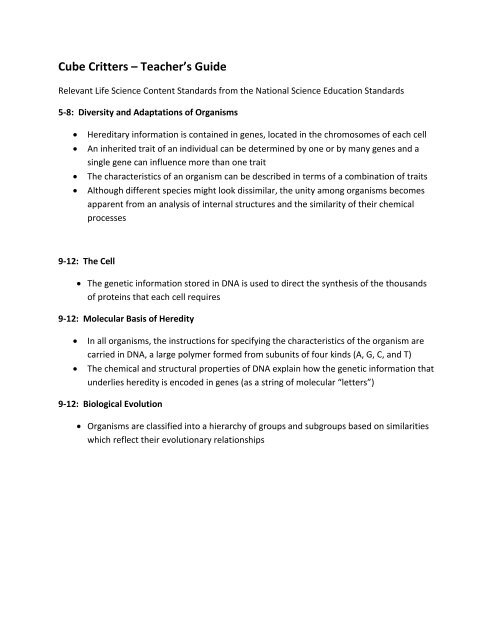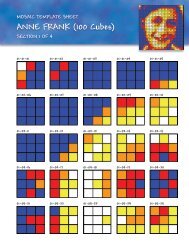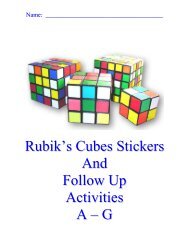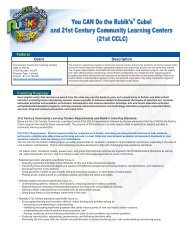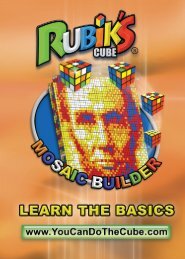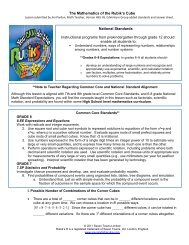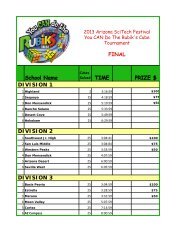Cube Critters – Teacher's Guide - You CAN Do the Rubik's Cube!
Cube Critters – Teacher's Guide - You CAN Do the Rubik's Cube!
Cube Critters – Teacher's Guide - You CAN Do the Rubik's Cube!
- No tags were found...
Create successful ePaper yourself
Turn your PDF publications into a flip-book with our unique Google optimized e-Paper software.
<strong>Cube</strong> <strong>Critters</strong> – Teacher’s <strong>Guide</strong>Relevant Life Science Content Standards from <strong>the</strong> National Science Education Standards5-8: Diversity and Adaptations of OrganismsHereditary information is contained in genes, located in <strong>the</strong> chromosomes of each cellAn inherited trait of an individual can be determined by one or by many genes and asingle gene can influence more than one traitThe characteristics of an organism can be described in terms of a combination of traitsAlthough different species might look dissimilar, <strong>the</strong> unity among organisms becomesapparent from an analysis of internal structures and <strong>the</strong> similarity of <strong>the</strong>ir chemicalprocesses9-12: The Cell The genetic information stored in DNA is used to direct <strong>the</strong> syn<strong>the</strong>sis of <strong>the</strong> thousandsof proteins that each cell requires9-12: Molecular Basis of HeredityIn all organisms, <strong>the</strong> instructions for specifying <strong>the</strong> characteristics of <strong>the</strong> organism arecarried in DNA, a large polymer formed from subunits of four kinds (A, G, C, and T)The chemical and structural properties of DNA explain how <strong>the</strong> genetic information thatunderlies heredity is encoded in genes (as a string of molecular “letters”)9-12: Biological Evolution Organisms are classified into a hierarchy of groups and subgroups based on similaritieswhich reflect <strong>the</strong>ir evolutionary relationships
This activity is used in my biology class when discussing RNA’s role in transcription andtranslation. The cube acts as our string of mRNA carrying <strong>the</strong> 18 traits for an imaginary creature<strong>the</strong> students will make. Each row on <strong>the</strong> cube will code for a single amino acid and to simplifythings, our traits are determined by just one amino acid. This activity works best doneindividually but pairs would work as well.The activity can be simplified by working in groups where each student is responsible for only afraction of <strong>the</strong> whole cube (1 side only, 2 sides, etc) and <strong>the</strong>n work toge<strong>the</strong>r on <strong>the</strong> drawing.Suggestion: The activity can also be used when discussing classification by having <strong>the</strong> studentsplace a collection of created organisms into classes, orders, families, etc based oncharacteristics of <strong>the</strong>ir choosing. They would <strong>the</strong>n need to be able to explain and justify <strong>the</strong>irclassification.Time1 day in-class (approximately 45 minutes to fill out data tables)3-5 days to complete drawing (can be shorter, I tell my students to take <strong>the</strong>ir time because I willhang <strong>the</strong>m up both in <strong>the</strong> room and <strong>the</strong> hallway)Materials (per group):1 Rubik’s cube1 <strong>Cube</strong> Critter handout1 Table of Traits (can be shared between 2 or 3 groups)Unlined paper (for final drawing, I prefer to use legal size printer paper)Colored pencils, crayons, or markersImportant notes:1) Its stated on <strong>the</strong> student handout but make sure to point out to <strong>the</strong> students that <strong>the</strong> centersquare on each side of <strong>the</strong> cube will never change spots and that’s how <strong>the</strong> faces are named. Sowhen it says “yellow face” it is dealing with <strong>the</strong> side of <strong>the</strong> cube with a yellow center.2) If you haven’t covered it before this activity, it may help to explain how to use a codon table.Left side is <strong>the</strong> first base, top is <strong>the</strong> second base, right side shows <strong>the</strong> last base.3) The diagram at <strong>the</strong> bottom of <strong>the</strong> handout shows a way to look at <strong>the</strong> cube so everyone isusing <strong>the</strong> same row for <strong>the</strong> same trait. It’s not absolutely necessary that everyone does this, itjust helps drive <strong>the</strong> point home that even when reading everything <strong>the</strong> same way, odds areyou’re going to have different traits.


